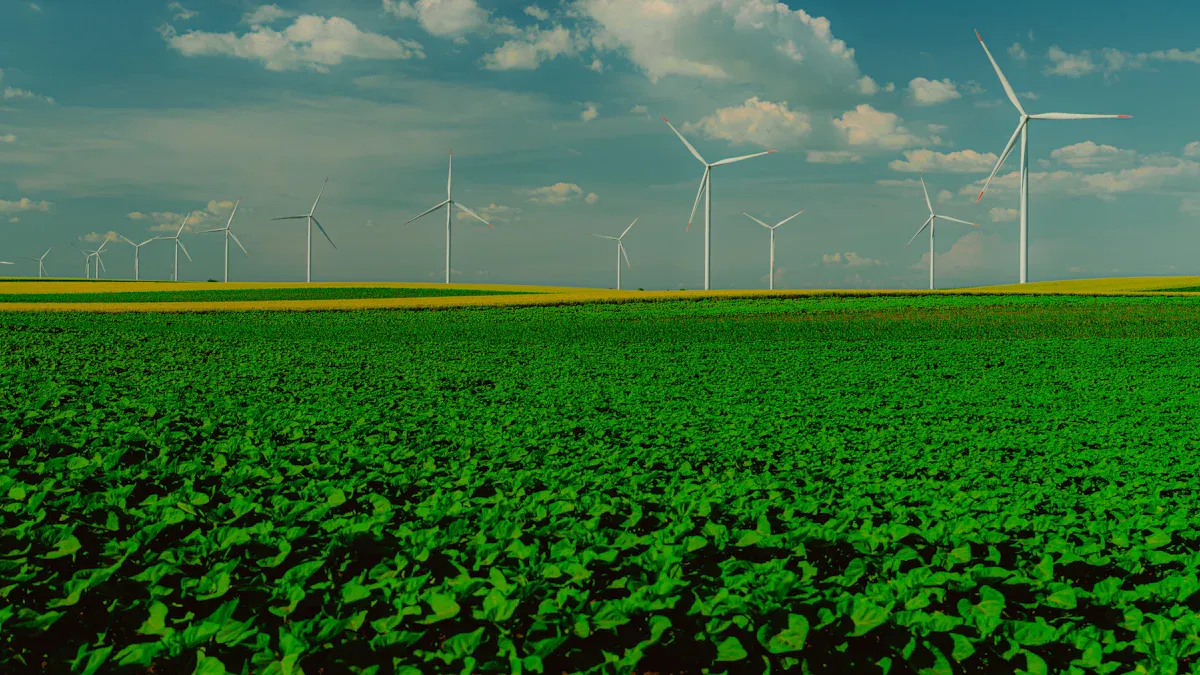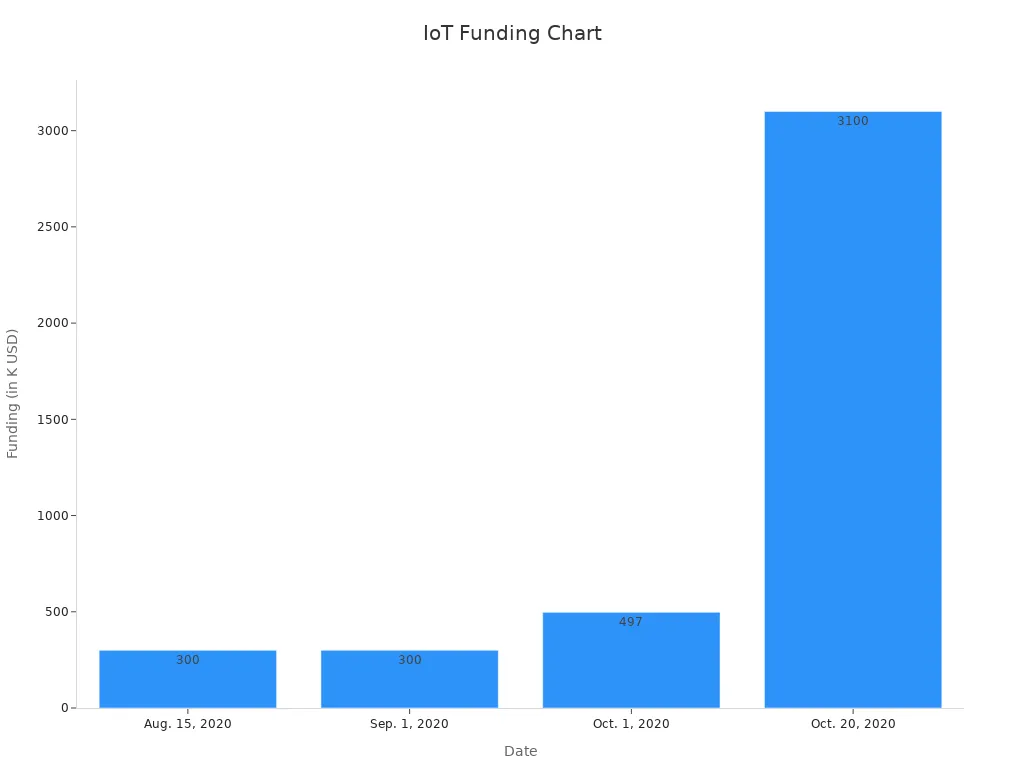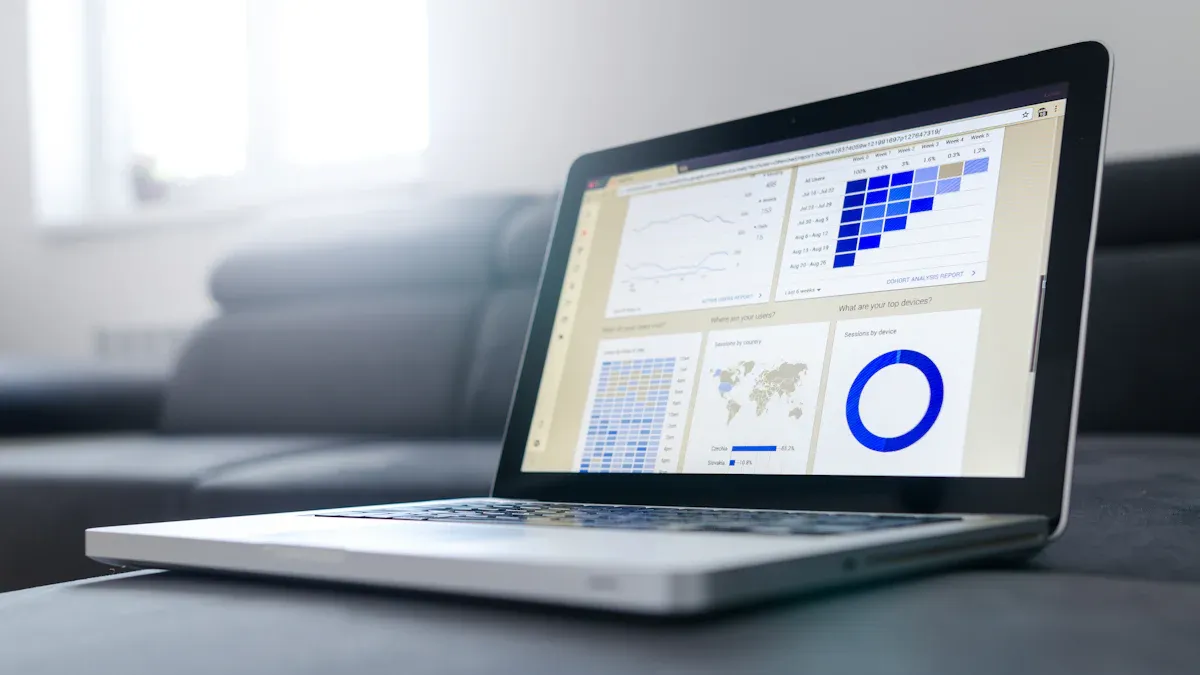IoT Environmental Monitoring Trends in 2025

IoT technology is transforming how you monitor the environment and address pressing issues like climate change. Its sensors offer precise data collection, enabling real-time insights into air quality, water pollution, and ecosystem health. The market for IoT environmental monitoring tools has soared, growing from USD 0.11 billion in 2017 to a projected USD 21.49 billion in 2025. This growth reflects your increasing demand for smarter solutions that reduce environmental impact while promoting sustainability. Companies now use IoT systems to assess wildfire risks, manage renewable energy, and track emissions, creating opportunities for you to profit while contributing to environmental sustainability.
Key Takeaways
IoT sensors are getting better and faster. They give real-time data to help monitor the environment. Using these tools can help you follow rules and work more efficiently.
Combining AI and machine learning with IoT makes data analysis smarter. This helps predict problems like pollution and climate change early. It also allows for quick action to fix them.
More people want IoT tools to help the planet. Using these systems can lower greenhouse gases and make your work smoother. This helps both nature and your business.
Real-time data and smart predictions help you decide faster. These tools let you spot problems early and solve them quickly.
Selling IoT environmental data can bring in extra money. You can try subscription plans or team up with others to make the most of your data.
Key Trends in IoT Environmental Monitoring for 2025

Advancements in IoT Sensor Technology
IoT sensors are becoming more advanced, enabling you to monitor environmental factors with greater precision. These sensors now offer real-time data collection for applications like air quality monitoring, water quality monitoring, and ecosystem health assessments. By 2025, the market value for IoT sensor technology is projected to reach $4,760.2 million, driven by increasing demand for real-time data and stricter environmental regulations.
Tip: Investing in IoT sensors can help you stay ahead of regulatory requirements while improving your monitoring systems' efficiency.
The advancements in IoT sensors also support smart energy management and industrial efficiency. For example, IoT-connected grids balance electricity supply and demand, optimizing renewable energy use. Factories use smart sensors to reduce energy waste, contributing to sustainability goals.
Year | Market Value (in million $) | CAGR (%) | Key Growth Drivers |
|---|---|---|---|
2025 | 4760.2 | 3.6 | Environmental regulations, pollution awareness, real-time data demand |
AI and Machine Learning Integration in IoT Systems
AI and machine learning are transforming IoT-based environmental monitoring. These technologies analyze vast amounts of data collected by IoT sensors, providing actionable insights. For instance, AI enhances climate prediction accuracy, helping you prepare for extreme weather events. Machine learning algorithms identify illegal logging in real time, aiding deforestation monitoring efforts.
Application | Measurable Impact |
|---|---|
Climate Prediction | Enhanced accuracy in forecasting weather patterns and climate trends, leading to better preparation and mitigation strategies. |
Deforestation Monitoring | Real-time identification of illegal logging through satellite imagery analysis, improving conservation efforts. |
Ocean Health Monitoring | Tracking pollution levels and ecosystem changes, predicting future environmental shifts. |
Air Quality Monitoring | Accurate forecasts of air quality and identification of pollution sources for effective control strategies. |
Biodiversity Conservation | Monitoring wildlife populations and migrations, aiding in conservation prioritization. |
Carbon Footprint Tracking | Accurate processing of emissions data for effective climate action and verification of offset projects. |
AI-powered IoT systems also improve air quality monitoring by identifying pollution sources and forecasting air quality changes. These insights enable you to take effective control measures, reducing environmental impact.
Rising Demand for IoT-Based Sustainability Solutions
The demand for IoT-based sustainability solutions is growing rapidly. Businesses and governments are adopting IoT systems to reduce greenhouse gas emissions and improve operational efficiency. By 2026, the potential market opportunity for IoT-based sustainability solutions is expected to reach $250 billion.
Metric | Value |
|---|---|
Potential market opportunity | USD 250 Bn by 2026 |
Supply chain emissions contribution | Up to 90% of greenhouse gas emissions |
A 1% increase in environmental performance correlates with a 0.114% increase in operational performance.
IoT systems play a crucial role in addressing supply chain emissions, which contribute up to 90% of greenhouse gas emissions. Smart farming tools, for example, optimize water and fertilizer use, boosting crop yields while minimizing waste. Similarly, traffic management systems in smart cities reduce congestion and emissions, while smart waste collection systems optimize fuel use.
Note: Adopting IoT-based sustainability solutions not only helps the environment but also improves your operational performance.
Real-Time Data and Predictive Analytics in Environmental Monitoring
Real-time data and predictive analytics are revolutionizing how you monitor and protect the environment. These tools allow you to collect, analyze, and act on environmental information as it happens, enabling faster and more informed decision-making. With the integration of IoT systems, environmental monitoring has become more precise and proactive, helping you address challenges like pollution, climate change, and resource management.
Predictive analytics uses historical and real-time data to forecast environmental trends. For example, it can predict air quality changes or water contamination risks, giving you the ability to implement preventive measures. IoT sensors play a critical role in this process by providing continuous streams of data from various sources, such as air, water, and soil.
Tip: Leveraging predictive analytics can help you anticipate environmental risks and reduce their impact before they escalate.
Key Benefits of Real-Time Data and Predictive Analytics
Enhanced Accuracy: Data-driven insights improve your ability to predict environmental changes, enabling proactive adaptation strategies.
Early Detection: Real-time monitoring systems powered by IoT help you assess risks more effectively, such as identifying pollution hotspots or detecting wildfire risks.
Targeted Monitoring: Machine learning techniques focus resources on areas of greatest concern, such as estimating water quality in vulnerable regions.
Integration with Early Warning Systems: Predictive analytics strengthens Early Warning Systems, allowing you to manage environmental threats more efficiently.
Comprehensive Data Utilization: Combining IoT sensor data with satellite imagery gives you a holistic view of environmental conditions, improving decision-making.
Benefit Type | Description |
|---|---|
Enhanced Accuracy | Data-driven trends and patterns improve prediction of environmental changes. |
Early Detection | Real-time monitoring systems lead to better risk assessment. |
Targeted Monitoring | Focused resource allocation improves water quality estimation. |
Integration with EWS | Early Warning Systems become more proactive with data analytics. |
Comprehensive Utilization | Sensor data combined with satellite imagery provides a holistic perspective. |
Real-World Applications
Predictive analytics powered by IoT is already making a difference in various sectors:
Air Quality Monitoring: IoT sensors track pollution levels in real time, enabling cities to implement measures that reduce emissions.
Wildlife Conservation: Predictive models analyze migration patterns, helping you prioritize conservation efforts.
Disaster Management: Early Warning Systems use predictive analytics to forecast floods, hurricanes, and other natural disasters, giving communities time to prepare.
These applications demonstrate how IoT and predictive analytics work together to create smarter, more sustainable solutions for environmental challenges.
Note: By adopting IoT-driven predictive analytics, you can not only protect the environment but also improve operational efficiency and reduce costs.
Earning Opportunities in IoT Environmental Monitoring
Monetizing Environmental Data
IoT-enabled environmental monitoring opens up lucrative opportunities for monetizing data. As industries and governments seek actionable insights to address environmental challenges, the demand for high-quality data continues to grow. You can leverage IoT platforms to collect, analyze, and sell environmental data to stakeholders like urban planners, researchers, and policymakers.
The market for data monetization is expanding rapidly. By 2025, the global data monetization market is estimated to reach $5 billion, with a compound annual growth rate (CAGR) of 19.94%. This growth reflects the increasing value of environmental data in decision-making processes. For example, cities deploying IoT sensors for air quality monitoring benefit from real-time data that helps reduce pollution and improve public health.
Market Segment | Estimated Value (2025) | Expected Value (2030) | CAGR (%) |
|---|---|---|---|
Data Monetization Market | USD 5.00 billion | USD 12.41 billion | 19.94% |
IoT Monetization Market | N/A | USD 5773.6 billion | 53.3% |
Global Data Monetization Market | USD 4.70 billion | USD 28.16 billion | 25.1% |
Tip: By investing in IoT-based environmental monitoring systems, you can tap into this growing market and generate revenue by selling valuable data to industries and governments.
Subscription-Based IoT Monitoring Services
Subscription models for IoT monitoring services offer a reliable way to generate recurring revenue. These services provide customers with access to real-time environmental data, predictive analytics, and advanced monitoring tools. You can create subscription packages tailored to specific needs, such as air quality monitoring for urban areas or water quality monitoring for agricultural regions.
The subscription economy is projected to grow from $650 billion to $1.5 trillion by 2025, highlighting the shift toward recurring revenue models. Subscription billing ensures predictable income streams and improves customer retention. Unlike traditional billing methods, this model allows you to scale your services while maintaining consistent revenue flows.
Subscription billing provides predictability and scalability in revenue generation.
It allows manufacturers to monetize data, which is a significant asset of IoT devices.
Long-term subscription models ensure cyclical revenue flows, reducing financial uncertainty.
Note: Offering subscription-based IoT monitoring services not only boosts your revenue but also strengthens customer loyalty by providing continuous value.
Developing IoT-Driven Environmental Products
Developing IoT-driven environmental products is another profitable avenue. These products, such as smart sensors and monitoring systems, address pressing environmental challenges while meeting the growing demand for sustainability solutions. You can design innovative tools for applications like air quality monitoring, water quality monitoring, and waste management.
The IoT market is poised for significant growth. Over the next decade, more than 125 billion IoT devices are expected to be connected globally, creating immense opportunities for product development. Investments in IoT technologies are projected to exceed $120 billion by 2021, further driving innovation in this space.
Evidence Description | Value | Source |
|---|---|---|
Expected IoT devices connected in 10 years | Over 125 billion | Techradar, 2019 |
Expected investments in IoT technologies by 2021 | Over 120 billion USD | Forbes, 2018 |
Estimated market value of raw materials from e-waste | More than 50 billion Euros | Globalewaste, 2017 |
Annual generation of e-waste | More than 44 million metric tonnes | Globalewaste, 2017 |
Tip: By developing IoT-driven environmental products, you can capitalize on the growing market demand while contributing to sustainability and reducing environmental impact.
Collaborations and Grants for IoT Projects
Collaborations and grants play a vital role in advancing IoT projects, especially in environmental monitoring. These partnerships bring together resources, expertise, and funding to tackle complex challenges. By working with universities, governments, and private organizations, you can access the tools and support needed to develop innovative IoT solutions.
The Role of Grants in IoT Development
Grants provide essential funding for IoT research and implementation. They enable you to explore new technologies, improve existing systems, and address pressing environmental issues. For example, the Cleveland Foundation awarded $3.1 million to establish two IoT research hubs in Northeast Ohio. These hubs focus on advancing IoT initiatives and fostering faculty engagement. Similarly, the National Science Foundation (NSF) has funded multiple projects, including $300,000 for secure wireless communication methods and $497,000 to mitigate network bottlenecks in distributed machine learning systems.
Date | Amount | Funding Organization | Project Title | Description |
|---|---|---|---|---|
Oct. 20, 2020 | $3.1M | Cleveland Foundation | CWRU/CSU Internet of Things Collaborative establishing pair of technology research hubs | This grant supports the establishment of two technology research hubs and expanding faculty engagement to advance IoT initiatives in Northeast Ohio. |
Oct. 1, 2020 | $497K | National Science Foundation | CNS Core: Small: Mitigating Network Bottlenecks via Programmability for Distributed Machine Learning Systems | The project aims to improve training efficiency for distributed machine learning systems, addressing network congestion challenges. |
Sep. 1, 2020 | $300K | National Science Foundation | EAGER: SARE: Collaborative: Low Energy Secure Wireless Transceivers for IoT Trusted Communications | This research focuses on developing low-energy secure communication methods for IoT, collaborating with The Ohio State University. |
Aug. 18, 2020 | N/A | U.S. Department of Energy | Smart Manufacturing Innovation Projects | The project aims to enhance productivity and energy efficiency in manufacturing through smart technologies, partnering with Rafter Equipment Corporation. |
Aug. 15, 2020 | $300K | National Science Foundation | EAGER: An AI-driven Paradigm for Collective and Collaborative Community Resilience in the COVID-19 Era and Beyond | This initiative explores AI-driven solutions for community resilience, particularly in response to challenges posed by the COVID-19 pandemic. |
Collaborations Driving IoT Innovation
Collaborations between organizations and institutions accelerate IoT innovation. By pooling resources, you can achieve goals that might be unattainable alone. For instance, the U.S. Department of Energy partnered with Rafter Equipment Corporation to enhance energy efficiency in manufacturing through smart technologies. These partnerships not only improve productivity but also contribute to sustainability.
Grants and collaborations also support environmental monitoring projects. They fund the development of IoT sensors and systems that track air quality, water pollution, and ecosystem health. These tools provide real-time data, enabling you to make informed decisions and address environmental challenges effectively.

How You Can Benefit
By seeking grants and forming collaborations, you can gain access to financial resources, technical expertise, and networking opportunities. These advantages help you develop IoT solutions that address environmental issues while creating economic value. Many organizations, such as the National Science Foundation and the Cleveland Foundation, offer funding for IoT projects. Applying for these grants can provide the support you need to bring your ideas to life.
Tip: Partnering with universities and research institutions can strengthen your grant applications and increase your chances of success.
Collaborations and grants not only drive IoT innovation but also foster a culture of sustainability. By leveraging these opportunities, you can contribute to environmental monitoring efforts and create a positive impact on the planet.
Real-World Examples of IoT Environmental Monitoring Success

Businesses Profiting from IoT Environmental Data
Businesses are leveraging IoT technologies to turn environmental data into profitable opportunities. By using IoT sensors, companies can monitor critical systems and optimize their operations. For example:
Manufacturing: Continuous monitoring of equipment conditions helps reduce unexpected breakdowns by 30%. This improves workflow efficiency and resource allocation.
Utilities: Smart meters automate energy usage data collection, enabling quicker resolution of billing issues and power outages. This enhances customer satisfaction and operational efficiency.
Healthcare: IoT-driven remote monitoring of medical equipment ensures reliability by reducing emergency repairs by up to 30%.
These examples highlight how IoT systems not only improve environmental monitoring but also drive cost savings and operational improvements. Businesses that adopt IoT solutions gain a competitive edge while contributing to sustainability.
Entrepreneurs Innovating IoT-Based Products
Entrepreneurs are creating innovative IoT products to address environmental challenges. These products often combine advanced sensors with real-time monitoring capabilities. For instance:
EcoPlastics: This company conducted a life cycle assessment (LCA) of its IoT-enabled packaging solutions. The results showed significant reductions in greenhouse gas emissions compared to traditional packaging.
CleanTech Solutions: By using IoT sensors to monitor energy consumption, this startup achieved a 20% reduction in energy use.
Entrepreneurs also measure success through metrics like greenhouse gas reductions and Social Return on Investment (SROI). These innovations demonstrate how IoT-based products can deliver measurable environmental and economic benefits.
Partnerships with Governments and NGOs for IoT Solutions
Collaborations between governments, NGOs, and private entities are advancing IoT-based environmental monitoring. For example, Similie partnered with PERMATIL to use cloud-based IoT technologies for monitoring water availability in Timor-Leste. This initiative supports climate resilience efforts in the WASH (Water, Sanitation, and Hygiene) sector.
Such partnerships also create integrated monitoring systems that inform policymaking in energy and environmental sectors. By networking these systems, stakeholders can address complex challenges like water scarcity and pollution more effectively. These collaborations highlight the potential of IoT to drive large-scale environmental impact.
Challenges and Solutions in IoT Environmental Monitoring
Addressing IoT Data Privacy Concerns
IoT systems collect vast amounts of environmental data, raising concerns about privacy and security. You may worry about how this data is stored, shared, and protected from unauthorized access. For example, hospitals often rely on manual methods to record temperature and humidity data, which can be tedious and prone to errors. IoT-enabled solutions automate this process, providing real-time monitoring and alerts. These systems improve response times in critical situations while ensuring data security through encryption and access controls.
To address privacy concerns, you can implement robust security measures. These include encrypted communication channels, secure data storage systems, and regular audits to identify vulnerabilities. By adopting these practices, you protect sensitive environmental data while maintaining trust with stakeholders.
Tip: Prioritize security features when deploying IoT systems to safeguard data and enhance reliability.
Overcoming High Initial Investment Costs
Deploying IoT environmental monitoring systems often requires significant upfront costs. You may face expenses related to hardware, software, and installation. Smaller organizations or entities with limited resources might find these financial burdens challenging. For example:
Installation costs for IoT sensors and devices can strain budgets.
Software licensing fees add to the overall expense.
Hardware components, such as servers and communication devices, require substantial investment.
To overcome these challenges, consider phased implementation strategies. Start with essential monitoring systems and expand gradually as resources allow. Explore funding opportunities like grants or partnerships to offset costs. Subscription-based models can also help you generate recurring revenue, reducing financial strain over time.
Note: Collaborating with stakeholders can provide access to shared resources, minimizing individual investment costs.
Ensuring Scalability and Reliability of IoT Systems
Scalability and reliability are critical for effective IoT environmental monitoring. You need systems that can adapt to growing demands and diverse settings. For instance, IoT systems for water quality monitoring must support continuous data collection and remote access. Reliable hardware and software ensure consistent performance, even in challenging conditions.
Metric/Consideration | Description |
|---|---|
Scalability | Ability to expand systems as needed |
Customization | Monitoring a wide range of parameters |
To enhance reliability, use energy-efficient devices with redundant power supplies. Employ robust communication channels to ensure uninterrupted data transmission. Regular maintenance and monitoring help you detect issues early, preventing system failures. Strong security measures protect data integrity, while fault-tolerant software handles errors effectively.
Tip: Invest in scalable and reliable IoT systems to future-proof your environmental monitoring efforts.
Navigating IoT Regulatory and Compliance Issues
IoT environmental monitoring systems must comply with various regulations to ensure data security, privacy, and ethical use. Navigating these requirements can feel overwhelming, but understanding the key challenges and solutions will help you stay compliant.
Key Challenges in IoT Compliance
Data Privacy Laws: Regulations like GDPR (General Data Protection Regulation) and CCPA (California Consumer Privacy Act) require you to protect user data and ensure transparency in data collection.
Cross-Border Data Transfers: IoT systems often operate globally, making it difficult to comply with different countries' data transfer laws.
Device Certification: Many regions mandate certifications for IoT devices to ensure they meet safety and performance standards.
Environmental Standards: IoT devices used for environmental monitoring must adhere to specific guidelines, such as emissions limits and energy efficiency requirements.
Tip: Familiarize yourself with local and international regulations to avoid legal complications.
Solutions to Regulatory Challenges
Implement Robust Security Measures: Encrypt data and use secure communication protocols to protect sensitive information.
Adopt Compliance Management Tools: Use software that tracks regulatory changes and ensures your systems meet the latest standards.
Collaborate with Legal Experts: Partner with compliance specialists to navigate complex regulations effectively.
Design for Compliance: Build IoT devices with features that align with environmental and safety standards from the start.
Challenge | Solution |
|---|---|
Data Privacy Laws | Encrypt data and ensure transparency in data collection. |
Cross-Border Data Transfers | Use cloud services that comply with international data transfer laws. |
Device Certification | Obtain certifications like CE or FCC for your IoT devices. |
Environmental Standards | Design energy-efficient devices that meet emissions guidelines. |
By addressing these challenges proactively, you can ensure your IoT systems operate within legal boundaries while maintaining trust with stakeholders.
Note: Staying updated on regulatory changes is crucial. Regular audits can help you identify and fix compliance gaps.
IoT environmental monitoring offers you a unique opportunity to combine profitability with sustainability. By adopting IoT solutions, you can reduce costs, improve efficiency, and make informed decisions. For example:
Smart sensors detect equipment issues early, boosting uptime by 10-20%.
Predictive maintenance reduces unplanned downtime and lowers costs by 5-10%.
Benefit Type | Description |
|---|---|
Predictive Maintenance | Advanced analytics models predict failures, reducing downtime and expenses. |
Efficiency Improvement | IoT integration increases productivity by 10-12% through workflow adjustments. |
Enhanced Decision-Making | Real-time data fosters agility in responding to market changes. |
Staying ahead of IoT trends in 2025 ensures you remain competitive while contributing to a sustainable future. Explore these opportunities to profit and protect the planet.
FAQ
What is IoT environmental monitoring?
IoT environmental monitoring uses connected sensors to collect real-time data about air, water, soil, and ecosystems. You can use this data to track pollution, predict climate trends, and improve sustainability efforts.
How can IoT help reduce greenhouse gas emissions?
IoT systems optimize energy use and monitor emissions. For example, smart grids balance electricity demand, while IoT sensors track supply chain emissions. These tools help you identify inefficiencies and implement greener practices.
Are IoT systems expensive to implement?
Initial costs can be high due to hardware and software investments. However, phased implementation, grants, and subscription models reduce financial strain. You can start small and scale up as resources grow.
How does IoT ensure data security?
IoT systems use encryption, secure communication channels, and regular audits to protect data. You can also implement access controls to prevent unauthorized use and ensure compliance with privacy laws.
Can IoT systems work in remote areas?
Yes, IoT systems can operate in remote locations using satellite connectivity or low-power networks. These technologies ensure reliable data collection even in areas with limited infrastructure.
See Also
Innovative Outdoor Communication Cabinets Designed for Sustainability in 2025
New Developments Shaping Outdoor Communication Cabinet Designs Today
Latest Innovations in Outdoor Telecom Cabinet Designs Unveiled
The Case for Custom Outdoor Communication Cabinets in 2025
Outdoor Cabinets Prepared for 5G Technology and Future Needs
CALL US DIRECTLY
86-13752765943
3A-8, SHUIWAN 1979 SQUARE (PHASE II), NO.111, TAIZI ROAD,SHUIWAN COMMUNITY, ZHAOSHANG STREET, NANSHAN DISTRICT, SHENZHEN, GUANGDONG, CHINA

